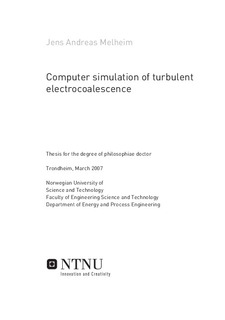| dc.contributor.author | Melheim, Jens Andreas | nb_NO |
| dc.date.accessioned | 2014-12-19T11:43:31Z | |
| dc.date.available | 2014-12-19T11:43:31Z | |
| dc.date.created | 2007-05-14 | nb_NO |
| dc.date.issued | 2007 | nb_NO |
| dc.identifier | 122364 | nb_NO |
| dc.identifier.isbn | 978-82-471-0895-6 | nb_NO |
| dc.identifier.uri | http://hdl.handle.net/11250/233325 | |
| dc.description.abstract | Offshore wells produce some water, and the ratio of water increases during the lifetime of a well, in particular when water is injected to increase the extraction rate. Hence, oil companies demand techniques that enhance the separation of oil and water. A speed-up of the separation process is achieved by applying electric fields to turbulent-flow water-in-oil emulsions. The electric field gives rise to attractive forces between close droplets and increases the probability of coalescence at contact, while the turbulence enhances the frequency of droplet collisions.
To improve the understanding of the mutual interaction between the turbulence and the electric field, this thesis presents a framework for computer simulation of turbulent electrocoalescence. The framework is based on the Eulerian-Lagrangian approach where each droplet is tracked and the electric and the hydrodynamic interactions between the droplets are handled.
The forces working between two droplets in stagnant oil are modelled and compared with experimental data. It was found that the electric dipole-dipole forces and the filmthinning forces dominate at small droplet spacings.
The turbulence felt by the droplets is modelled by a stochastic differential-equation model. A new model is proposed to correlate the fluid velocities seen by close droplets, and this is important for the prediction of the collision velocity, the collision frequency, and the clustering of droplets.
Two algorithmic improvements are made: An adaptive cell structure and the cluster integration method. The proposed adaptive cell structure adapts to the number density of droplets and ensures an efficient computation without any input from the user regarding the cell structure. The cluster integration method assembles clusters of droplets that interact and integrates each cluster separately using a variable step-size Runge-Kutta method. A significant speed-up compared to traditional approaches is reported.
Finally, the results obtained by computer simulations of turbulent electrocoalescence agree qualitatively with experimental observations in the literature. | nb_NO |
| dc.language | eng | nb_NO |
| dc.publisher | Fakultet for ingeniørvitenskap og teknologi | nb_NO |
| dc.relation.ispartofseries | Doktoravhandlinger ved NTNU, 1503-8181; 2007:41 | nb_NO |
| dc.relation.haspart | Melheim, J.A; Chiesa, M; Ingebrigtsen, S; Berg, G. Forces between two water droplets in oil under the influence of an electric field. In 5th International Conference on Multiphase Flow ICMF’04, Yokohama, Japan., June 2004, 2004. | nb_NO |
| dc.relation.haspart | Melheim, J.A. Cluster integration method in Lagrangian particle dynamics. Computer Physics Communications. 171: 155-161, 2005. | nb_NO |
| dc.relation.haspart | Melheim, J.A; Horender, S; Sommerfeld, M. Modeling of the vortexstructure in a particleladen mixinglayer. In 2005 ASME FEDSM, GasParticle Flows, Houston, Texas, USA, June 2005, 2005. | nb_NO |
| dc.title | Computer simulation of turbulent electrocoalescence | nb_NO |
| dc.type | Doctoral thesis | nb_NO |
| dc.contributor.department | Norges teknisk-naturvitenskapelige universitet, Fakultet for ingeniørvitenskap og teknologi, Institutt for energi- og prosessteknikk | nb_NO |
| dc.description.degree | PhD i energi- og prosessteknikk | nb_NO |
| dc.description.degree | PhD in Energy and Process Engineering | en_GB |
